Popular categories
Looking for a yarn?
The yarn cost is calculated from the pattern’s smallest size and the yarn’s cheapest product type. Looking for an even better price? You might find it on the DROPS Deals!
Spice Market Cardigan
Knitted jacket in DROPS Sky. Piece is knitted top down with raglan, textured pattern and vents in the sides. Size: S - XXXL
DROPS design: Pattern sk-169
Yarn group B
----------------------------------------------------------
SIZE:
S - M - L - XL - XXL - XXXL
MATERIALS:
DROPS SKY from Garnstudio (belongs to yarn group B)
300-350-400-400-450-500 g colour 11, hazelnut
DROPS BUTTON NO 629: 6-6-6-6-7-7 pieces
NEEDLES:
DROPS CIRCULAR NEEDLE SIZE 4.5 mm: Length 40 and 80 cm.
DROPS CIRCULAR NEEDLE SIZE 3.5 mm: Length 40 and 80 cm.
DROPS DOUBLE POINTED NEEDLES SIZE 4.5 mm
DROPS DOUBLE POINTED NEEDLES SIZE 3.5 mm
The technique MAGIC LOOP can be used – you then only need circular needle of 80 cm in each size.
KNITTING TENSION:
20 stitches in width and 26 rows vertically in stocking stitch = 10 x 10 cm.
NOTE! Remember that needle size is only a suggestion. If you have too many stitches on 10 cm switch to larger needles. If you have too few stitches on 10 cm switch to smaller needles.
-------------------------------------------------------
Alternative Yarn – See how to change yarns here
Yarn Groups A to F – Use the same pattern and change the yarn here
Yarn usage using an alternative yarn – Use our yarn converter here
-------------------------------------------------------
The yarn cost is calculated from the pattern’s smallest size and the yarn’s cheapest product type. Looking for an even better price? You might find it on the DROPS Deals!
- English (UK/cm), Latvia
- Česky
- Dansk
- Deutsch
- Eesti keel
- English (UK/cm)
- English (US/in)
- Español
- Français
- Íslenska
- Italiano
- Magyar
- Nederlands
- Norsk
- Polski
- Português
- Suomi
- Svenska
- English (UK/cm), Bulgaria
- English (UK/cm), Croatia
- English (UK/cm), Greece
- English (UK/cm), Lithuania
- English (UK/cm), Romania
- English (UK/cm), Slovenia
- Česky, Slovakia
Pattern instructions
EXPLANATION FOR THE PATTERN:
----------------------------------------------------------
GARTER STITCH (back and forth):
Knit all rows.
1 ridge vertically = knit 2 rows.
PATTERN:
See diagrams A.1 to A.5. Choose diagram for your size in A.2 and A.3.
BUTTONHOLES:
Decrease for buttonholes on right band (when garment is worn). Decrease from right side when 5 stitches remain on row as follows: Cast off the next 2 stitches, knit the next 3 stitches. On next row cast on 2 new stitches over the cast off stitches.
Cast off first button hole right after rib in the neck. Then decrease the next 5-5-5-5-6-6 buttonholes, approx. 9-9-10-10-9-9 cm between each.
RAGLAN (applies to sleeves):
All increases are done from the right side.
Increase 1 stitch before/after marker threads on sleeves as follows: Work until first marker thread on sleeve, knit 1, make 1 yarn over, work until 1 stitch before next marker thread, make 1 yarn over, knit 1. Repeat on the other sleeve (= 4 stitches increased on sleeves). On next row (wrong side) purl yarn over twisted to avoid holes. Then work the new stitches in stocking stitch.
DECREASE TIP (applies to sleeves):
Decrease 1 stitch on each side of marker thread: Work until 3 stitches remain before marker thread and knit 2 together, knit 2 (marker thread is between these 2 stitches), slip 1 stitch knitwise, knit 1, pass slipped stitch over stitch worked.
----------------------------------------------------------
START THE PIECE HERE:
----------------------------------------------------------
JACKET - SHORT OVERVIEW OF THE PIECE:
Work double neck edge and yoke back and forth on circular needle work top down. Work body back and forth in one down to vent in the sides, then finish front pieces and back back and forth separately. Work sleeves in the round on a short circular needle/double pointed needles.
DOUBLE NECK EDGE:
Cast on 119-123-129-133-139-143 stitches with DROPS Sky over a short circular needle size 4.5 and a short circular needle size 3.5 mm held together.
Pull out circular 4.5 mm and keep stitches on the short circular needle size 3.5 mm (cast is done like this to get an elastic cast-on edge). Purl 1 row from wrong side, then work as follows from right side: * Knit 1, purl 1 *, work from *-* until 1 stitch remain, knit 1. Work like this until piece measures 7 cm. Now cast on 8 new stitches in each side = 135-139-145-149-155-159 stitches. Continue rib as before, work the outermost 8 stitches in each side in GARTER STITCH – read explanation above (= band stitches). This way the neck edge is worked double but the band stitches in garter stitch are not double (edge towards mid front will not be as thick when buttoned). Work rib until piece measures 14 cm. Now fold the rib inwards to form a double edge - then work next row from right side in rib as before, at the same time work every other stitch together with every other stitch from cast-on edge (begin and end with 8 stitches in garter stitch in each side). You now have a double neck edge. Insert 1 marker here – measure the piece from here.
YOKE:
Switch to circular needle size 4.5 mm. Purl 1 row from wrong side while decreasing 26-26-28-28-30-30 stitches evenly(work bands in garter stitch and do not decrease over bands) = 109-113-117-121-125-129 stitches. Work pattern as follows from right side:
8 band stitches in garter stitch, A.1, A.2, insert 1 marker thread here (left front piece), knit 1 stitch, make 1 yarn over, knit 11-13-15-9-11-13, make 1 yarn over, knit 1, insert a marker thread here (sleeve), A.3, A.4 (mid back), A.2, insert a marker thread here (back piece), knit 1, make 1 yarn over, knit 11-13-15-9-11-13, make 1 yarn over, knit 1, insert a marker thread here (sleeve), A.3, A.5, 8 band stitches in garter stitch (right front piece). 1 stitch for RAGLAN has now been increased – read explanation above, in each side of sleeve and 1 stitch has been increased on each A.2/A.3 on front pieces and back piece = 117-121-125-129-133-137 stitches. REMEMBER THE KNITTING TENSION and remember BUTTONHOLES - see explanation above.
Continue back and forth like this and increase for raglan on sleeves every other row 21-25-26-31-31-30 more times (22-26-27-32-32-31 times in total), AT THE SAME TIME when diagrams have been worked vertically, repeat the last 2 rows vertically 20-23-27-28-33-36 more times (i.e. until there are 55-61-69-71-81-87 stitches in stocking stitch between A.2/A.3 on back piece and there are 28-31-35-36-41-44 stitches in stocking stitch between A.2/A.3 and the front band stitches on each of front piece) = 301-333-357-385-409-421 stitches.
Continue with texture over the 15-15-15-19-19-19 stitches in A.2 and A.3, 8 band stitches in garter stitch in each side towards mid front and stocking stitch over the remaining stitches until piece measures 22-24-26-28-30-32 cm measured from marker mid front.
Work next row from wrong side as follows: Work pattern as before over the first 51-54-58-63-68-71 stitches (= right front piece), slip the next 57-67-71-75-77-77 stitches on a thread (= sleeve), cast on 10-10-10-12-12-16 new stitches on needle (= in the side under sleeve), work the next 85-91-99-109-119-125 stitches (= back piece), slip the next 57-67-71-75-77-77 stitches on a thread (= sleeve), cast on 10-10-10-12-12-16 stitches on needle (= in the side under sleeve), work the remaining 51-54-58-63-68-71 stitches on needle (= left front piece). Now measure piece from here!
BODY:
= 207-219-235-259-279-299 stitches.
Continue with the last 2 rows in A.2 and A.3, 8 band stitches in garter stitch in each side towards mid front, and stocking stitch over the remaining stitches.
Work until piece measures 22 cm.
Slip the first and last 56-59-63-69-74-79 stitches on a thread for left and right front piece. Then finish front/back piece separately to get a vent in each side.
BACK PIECE:
= 95-101-109-121-131-141 stitches. Knit 1 row from right side while increasing 24-24-28-28-32-38 stitches evenly = 119-125-137-149-163-179 stitches. Switch to circular needle size 3.5 mm. Work rib as follows – from wrong side: 2 edge stitches in garter stitch, * purl 1, knit 1 *, work from *-* until 3 stitches remain, purl 1 and 2 edge stitches in garter stitch. When rib measures 8 cm, cast off with knit over knit and purl over purl. Jacket measures approx. 56-58-60-62-64-66 cm from shoulder and down.
RIGHT FRONT PIECE:
Slip the 56-59-63-69-74-79 stitches from thread back on circular needle size 4.5 mm. Purl 1 row from wrong side while increasing 13-12-16-16-19-22 stitches evenly = 69-71-79-85-93-101 stitches. Switch to circular needle size 3.5 mm. Work rib as follows – from wrong side: 2 edge stitches in garter stitch, * purl 1, knit 1 *, work from *-* until 9 stitches remain, purl 1 and 8 band stitches in garter stitch. When piece measures 8 cm, cast off.
LEFT FRONT PIECE:
Work the same way as on right front piece but reversed.
SLEEVE:
Slip the 57-67-71-75-77-77 stitches from thread in one side of piece on a short circular needle/double pointed needles size 4.5 mm and pick in addition up 1 stitch in each of the 10-10-10-12-12-16 stitches cast on under sleeve = 67-77-81-87-89-93 stitches. Insert 1 marker thread in the middle of the new stitches under sleeve (= 5-5-5-6-6-8 new stitches on each side of marker thread). Work in stocking stitch in the round. When piece measures 4 cm from division, decrease 2 stitches mid under sleeve - read DECREASE TIP. Decrease like this every 7½-3½-3-2-2-2 cm 5-9-10-12-12-13 times in total. When all decreases are done, there are 57-59-61-63-65-67 stitches on round. Work until sleeve measures 37-35-34-32-31-29 cm from division. Knit 1 round while increasing 11 stitches evenly = 68-70-72-74-76-78 stitches. Switch to double pointed needles size 3.5 mm and work rib = knit 1/purl 1 for 4 cm. Cast off. Sleeve measures approx. 41-39-38-36-35-33 cm from division. Work the other sleeve the same way.
ASSEMBLY:
Sew opening towards mid front together on bands with neat little stitches. Sew the buttons on to the left band.
Diagram

|
= knit from the right side, purl from the wrong side |

|
= purl from right side |

|
= between 2 stitches make 1 yarn over, on next row work yarn over twisted (to avoid holes) |

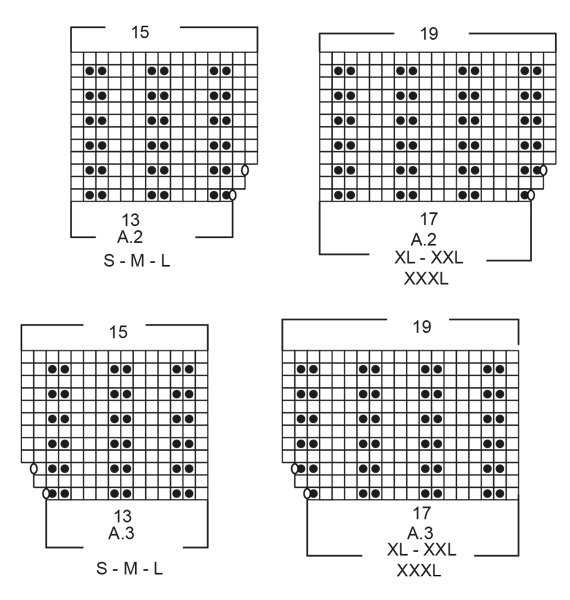
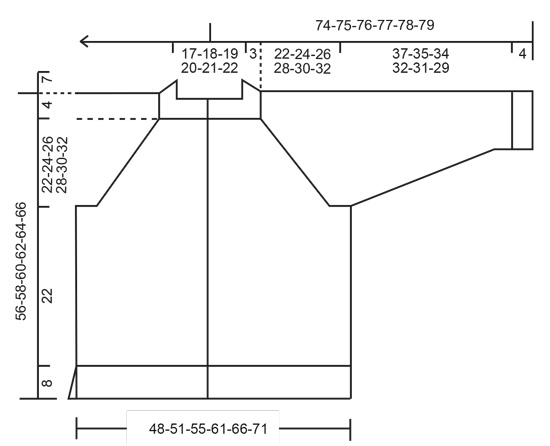
What can you do with our patterns? You can share DROPS patterns online, using the pattern original picture, materials, name and number. But you are NOT ALLOWED to reproduce the complete pattern digitally in any way. Yarn stores are welcome to use the DROPS pattern database to promote the sale of our assortment. You can print out our patterns, make as many copies as you’d like. The only thing we ask is that you don't make any changes / additions to the original printed document. And that the patterns according to the DROPS philosophy are given out to the consumers for free. Editorials that wish to publish our patterns in printed books or magazines can contact us for more information. The sale of garments based on DROPS patterns is permitted as long as they are sold as single items or per order. Further commercial use of the patterns is not permitted. It has to be clearly stated that the garment is made based on a design from DROPS DESIGN. The use of clothing labels of which DROPS DESIGN forms part is conditioned by the inclusion of the following text: “A DROPS DESIGN made by …..”. The use of DROPS photos for marketing purposes/sales is only permitted in connection with the use/sale of DROPS products. The photos may not be cut or edited and the logo should be clearly visible.
We reserve the right to withdraw the permission for use of our patterns at any time, notwithstanding the reason.
Each of our patterns has specific tutorial videos to help you.
These step-by-step tutorials might also help you:
Why is the knitting/crochet tension so important?
Knitting tension is what determines the final measurements of your work, and is usually measured per 10 x 10 cm. It is provided like so: number of stitches in width x number of rows in height - eg: 19 stitches x 26 rows = 10 x 10 cm.
The knitting tension is very individual; some people knit/crochet loosely while others work tightly. You adjust the knitting tension with the needle size, which is why the suggested needle size is only meant as a guide! You need to adjust this (up or down) to ensure that YOUR knitting tension matches the knitting tension provided in the pattern. If you work with a different knitting tension than provided you will have a different yarn consumption, and your work will have different measurements than what the pattern suggests.
The knitting tension also determines which yarns can replace each other. As long as you achieve the same knitting tension you can replace one yarn with another.
See DROPS lesson: How to measure your tension/gauge
See DROPS video: How to make a gauge tension swatch
How do I know how many balls of yarn I need?
The required amount of yarn is provided in grams, eg: 450 g. To calculate how many balls you’ll need you first need to know how many grams are in 1 ball (25g, 50g or 100g). This information is available if you click on the individual yarn quality on our pages. Divide the amount required with the amount of each ball. For example, if each ball is 50g (the most common amount), the calculation will be as follows: 450 / 50 = 9 balls.
Can I use a different yarn than what the pattern suggests?
The important thing when changing from one yarn to another is that the knitting/crochet tension remains the same. This is so that the measurements of the finished piece will be the same as on the sketch provided. It is easier to achieve the same knitting tension using yarns from the same yarn group. It is also possible to work with multiple strands of a thinner yarn to achieve the knitting tension of a thicker one. Please try our yarn converter. We recommend you to always work a test swatch.
Please NOTE: when changing yarn the garment might have a different look and feel to the garment in the photo, due to individual properties and qualities of each yarn.
See DROPS lesson: Can I use a different yarn than the one mentioned in the pattern?
What are the yarn groups?
All our yarns are categorised into yarn groups (from A to F) according to thickness and knitting tension – group A contains the thinnest yarns and group F the thickest. This makes it easier for you to find alternative yarns to our patterns, should you wish to switch yarn. All yarns within the same group have a similar knitting tension and can easily replace each other. However, different yarn qualities have different structures and properties which will give the finished work a unique look and feel.
How do I use the yarn calculator?
At the top of all our patterns you’ll find a link to our yarn calculator, which is a helpful tool should you wish to use a different yarn than suggested. By filling in the yarn quality you wish to replace, the amount (in your size) and number of strands, the calculator will present good alternative yarns with the same knitting tension. Additionally it will tell you how much you’ll require in the new qualities and whether you’ll need to work with multiple strands. Most skeins are 50g (some are 25g or 100g).
If the pattern is worked with multiple colours, every colour will have to be calculated separately. Similarly, if the pattern is worked with several strands of different yarns (for example 1 strand Alpaca and 1 strand Kid-Silk) you will have to find alternatives for each, individually.
Why do you show discontinued yarns in the patterns?
Since different yarns have different qualities and textures we have chosen to keep the original yarn in our patterns. However, you can easily find options among our available qualities by using our yarn calculator, or simply pick a yarn from the same yarn group.
It is possible that some retailers still have discontinued yarns in stock, or that someone has a few skeins at home that they would like to find patterns for.
The yarn calculator will provide both alternative yarn as well as required amount in the new quality.
What size should I knit?
If you think it's hard to decide what size to make, it can be a good idea to measure a garment you own already and like the size of. Then you can pick the size by comparing those measures with the ones available in the pattern's size chart.
You'll find the size chart at the bottom of the pattern.
See DROPS lesson: How to read size chart
Why do I get the wrong knitting tension with the suggested needle size?
The needle size provided in the pattern serves only as a guide, the important thing is to follow the knitting tension. And since knitting tension is very individual, you will have to adjust the needle size to ensure that YOUR tension is the same as in the pattern – maybe you’ll have to adjust 1, or even 2 needle sizes, up or down to achieve the correct tension. For this, we recommend that you work test swatches.
Should you work with a different knitting tension than the one provided, the measurements of the finished garment might deviate from the measurement sketch.
See DROPS lesson: How to measure your tension/gauge
See DROPS video: How to make a tension/gauge swatch
Why is the pattern worked top-down?
Working a garment top-down provides more flexibility and room for personal adjustment. For example it is easier to try the garment on while working, as well as making adjustments to length of yoke and shoulder caps.
The instructions are carefully explaining every step, in the correct order. Diagrams are adjusted to the knitting direction and are worked as usual.
How do I work according to a knitting diagram?
The diagram depicts all rows/rounds, and every stitch seen from the right side. It is read from bottom to top, from right to left. 1 square = 1 stitch.
When working back and forth, every other row is worked from the right side and every other row is worked from the wrong side. When working from the wrong side, the diagram will have to be worked reversed: from left to right, knit stitches are purled, purl stitches are knit etc.
When working in the round every round is worked from the right side and the diagram are worked from right to left on all rounds.
See DROPS lesson: How to read knitting diagrams
How do I work according to a crochet diagram?
The diagram depicts all rows/rounds, and every stitch seen from the right side. It is worked from bottom to top, from right to left.
When working back and forth every other row is worked from the right side: from right to left and every other row is worked from the wrong side: from left to right.
When working in the round, every row in the diagram are worked from the right side, from right to left.
When working a circular diagram you start in the middle and work your way outwards, counter clockwise, row by row.
The rows usually start with a given number of chain stitches (equivalent to the height of the following stitch), this will either be depicted in the diagram or explained in the pattern.
See DROPS lesson: How to read crochet diagrams
How do I work several diagrams simultaneously on the same row/round?
Instructions for working several diagrams after each other on the same row/round, will often be written like so: “work A.1, A.2, A.3 a total of 0-0-2-3-4 times". This means you work A.1 once, then A.2 is worked once, and A.3 is repeated (in width) the number of times provided for your size – in this case like so: S = 0 times, M = 0 times, L=2 times, XL= 3 times and XXL = 4 times.
The diagrams are worked as usual: begin with the first row in A.1, then work the first row in A.2 etc.
See DROPS lesson: How to read knitting diagrams
See DROPS lesson: How to read crochet diagrams
Why are the sleeves shorter in larger sizes?
The total width of the garment (from wrist-to-wrist) will be larger in the larger sizes, despite the actual sleeves being shorter. The larger sizes have longer sleeve caps and wider shoulders, so there will be a good fit in all sizes.
Where on the garment is the length measured?
The measurement sketch/schematic drawing provides information regarding the full length of the garment. If it’s a jumper or a jacket the length is measured from the highest point on the shoulder closest to the neckline, and straight down to the bottom of the garment. It is NOT measured from the tip of shoulder. Similarly, the length of yoke is measured from the highest point on the shoulder and down to where yoke is split into body and sleeves.
On a jacket measures are never taken along bands, unless specifically stated. Always measure inside band stitches when measuring the length.
See DROPS lesson: How to read a schematic drawing
What is a repeat?
Diagrams are often repeated on the round or in height. 1 repeat is the diagram the way it appears in the pattern. If it says to work 5 repeats of A.1 in the round, then you work A.1 a total of 5 times after/next to each other in the round. If it says to work 2 repeats of A.1 vertically/in height you work the entire diagram once, then begin again at the start and work the entire diagram one more time.
Why does the piece start with more chain stitches than it’s worked with?
Chain stitches are slightly narrower than other stitches and to avoid working the cast-on edge too tight, we simply chain more stitches to begin with. The stitch count will be adjusted on the following row to fit the pattern and measurement sketch.
Why increase before the rib edge when the piece is worked top-down?
The rib edge is more elastic and will contract slightly compared to, for example, stocking stitch. By increasing before the rib edge, you avoid a visible difference in width between the rib edge and the rest of the body.
Why increase in the cast-off edge?
It’s very easy to cast off too tightly, and by making yarn overs while casting off (and simultaneously casting these off) you avoid a too tight cast off edge.
See DROPS video: How to bind off with yarn overs (yo)
How do I increase/decrease on every 3rd and 4th row/round alternately?
To achieve an even increase (or decrease) you can increase on, for example: every 3rd and 4th row alternately, like so: work 2 rows and increase on the 3rd row, work 3 rows and increase on the 4th. Repeat this until the increase is complete.
See DROPS lesson: Increase or decrease 1 st on every 3rd and 4th row alternately
How can I work a jacket in the round instead of back and forth?
Should you prefer to work in the round instead of back and forth, you may of course adjust the pattern. You’ll need to add steeks mid-front (usually 5 stitches), and follow the instructions. When you would normally turn and work from the wrong side, simply work across the steek and continue in the round. At the end you’ll cut the piece open, pick up stitches to work bands, and cover the cut edges.
See DROPS video: How to knit steeks and cut open
Can I work a jumper back and forth instead of in the round?
Should you prefer to work back and forth instead of in the round, you may of course adjust the pattern so you work the pieces separately and then assemble them at the end. Divide the stitches for the body in 2, add 1 edge stitch in each side (for sewing) and work the front and back pieces separately.
See DROPS lesson: Can I adapt a pattern for circular needles into straight needles?
Why is the pattern slightly different than what I see in the photo?
Pattern repeats can vary slightly in the different sizes, in order to get the correct proportions. If you’re not working the exact same size as the garment in the photo, yours might deviate slightly. This has been carefully developed and adjusted so that the complete impression of the garment is the same in all sizes.
Make sure to follow instructions and diagrams for your size!
How do I make a women’s size garment into a men’s size one?
If you have found a pattern you like which is available in women’s size it’s not very difficult to convert it to men’s size. The biggest difference will be the length of sleeves and body. Start working on the women size that you think would fit across the chest. The additional length will be worked right before you cast off for the armhole/sleeve cap. If the pattern is worked top-down you can add the length right after the armhole or before the first decrease on sleeve.
Regarding additional yarn amount, this will depend on how much length you add, but it is better with a skein too many than too few.
How do I prevent a hairy garment from shedding?
All yarns will have excess fibres (from production) that might come off as lint or shedding. Brushed yarns (ie hairier yarns) have more of these loose, excess fibres, causing more shedding.
Shedding also depends on what is worn under or over the garment, and whether this pulls at the yarn fibres. It’s therefore not possible to guarantee that there will be no shedding
Below are some tips on how to get the best result when working with hairier yarns:
1. When the garment is finished (before you wash it) shake it vigorously so the looser hairs come off. NOTE: do NOT use a lint roller, brush or any method that pulls at the yarn.
2. Place the garment in a plastic bag and put it in your freezer - the temperature will cause the fibres to become less attached to each other, and excess fibres will come off easier.
3. Leave in the freezer for a few hours before taking it out and shaking it again.
4. Wash the garment according to the instructions on the yarn label.
Why does my garment pill?
Pilling is a natural process that happens to even the most exclusive of fibers. It's a natural sign of wear and tear that is hard to avoid, and that is most visible in high friction areas of your garment like a sweater's arms and cuffs.
You can make your garment look as new by removing the pilling, using a fabric comb or a pill/lint remover.
In the meantime, you can read the questions and answers that others have left to this pattern or join the DROPS Workshop on Facebook to get help from fellow knitters/crocheters!
You might also like...
Spice Market Cardigan |
||||||||||
 |
 |
|||||||||
Knitted jacket in DROPS Sky. Piece is knitted top down with raglan, textured pattern and vents in the sides. Size: S - XXXL
DROPS 236-27 |
||||||||||
|
---------------------------------------------------------- EXPLANATION FOR THE PATTERN: ---------------------------------------------------------- GARTER STITCH (back and forth): Knit all rows. 1 ridge vertically = knit 2 rows. PATTERN: See diagrams A.1 to A.5. Choose diagram for your size in A.2 and A.3. BUTTONHOLES: Decrease for buttonholes on right band (when garment is worn). Decrease from right side when 5 stitches remain on row as follows: Cast off the next 2 stitches, knit the next 3 stitches. On next row cast on 2 new stitches over the cast off stitches. Cast off first button hole right after rib in the neck. Then decrease the next 5-5-5-5-6-6 buttonholes, approx. 9-9-10-10-9-9 cm between each. RAGLAN (applies to sleeves): All increases are done from the right side. Increase 1 stitch before/after marker threads on sleeves as follows: Work until first marker thread on sleeve, knit 1, make 1 yarn over, work until 1 stitch before next marker thread, make 1 yarn over, knit 1. Repeat on the other sleeve (= 4 stitches increased on sleeves). On next row (wrong side) purl yarn over twisted to avoid holes. Then work the new stitches in stocking stitch. DECREASE TIP (applies to sleeves): Decrease 1 stitch on each side of marker thread: Work until 3 stitches remain before marker thread and knit 2 together, knit 2 (marker thread is between these 2 stitches), slip 1 stitch knitwise, knit 1, pass slipped stitch over stitch worked. ---------------------------------------------------------- START THE PIECE HERE: ---------------------------------------------------------- JACKET - SHORT OVERVIEW OF THE PIECE: Work double neck edge and yoke back and forth on circular needle work top down. Work body back and forth in one down to vent in the sides, then finish front pieces and back back and forth separately. Work sleeves in the round on a short circular needle/double pointed needles. DOUBLE NECK EDGE: Cast on 119-123-129-133-139-143 stitches with DROPS Sky over a short circular needle size 4.5 and a short circular needle size 3.5 mm held together. Pull out circular 4.5 mm and keep stitches on the short circular needle size 3.5 mm (cast is done like this to get an elastic cast-on edge). Purl 1 row from wrong side, then work as follows from right side: * Knit 1, purl 1 *, work from *-* until 1 stitch remain, knit 1. Work like this until piece measures 7 cm. Now cast on 8 new stitches in each side = 135-139-145-149-155-159 stitches. Continue rib as before, work the outermost 8 stitches in each side in GARTER STITCH – read explanation above (= band stitches). This way the neck edge is worked double but the band stitches in garter stitch are not double (edge towards mid front will not be as thick when buttoned). Work rib until piece measures 14 cm. Now fold the rib inwards to form a double edge - then work next row from right side in rib as before, at the same time work every other stitch together with every other stitch from cast-on edge (begin and end with 8 stitches in garter stitch in each side). You now have a double neck edge. Insert 1 marker here – measure the piece from here. YOKE: Switch to circular needle size 4.5 mm. Purl 1 row from wrong side while decreasing 26-26-28-28-30-30 stitches evenly(work bands in garter stitch and do not decrease over bands) = 109-113-117-121-125-129 stitches. Work pattern as follows from right side: 8 band stitches in garter stitch, A.1, A.2, insert 1 marker thread here (left front piece), knit 1 stitch, make 1 yarn over, knit 11-13-15-9-11-13, make 1 yarn over, knit 1, insert a marker thread here (sleeve), A.3, A.4 (mid back), A.2, insert a marker thread here (back piece), knit 1, make 1 yarn over, knit 11-13-15-9-11-13, make 1 yarn over, knit 1, insert a marker thread here (sleeve), A.3, A.5, 8 band stitches in garter stitch (right front piece). 1 stitch for RAGLAN has now been increased – read explanation above, in each side of sleeve and 1 stitch has been increased on each A.2/A.3 on front pieces and back piece = 117-121-125-129-133-137 stitches. REMEMBER THE KNITTING TENSION and remember BUTTONHOLES - see explanation above. Continue back and forth like this and increase for raglan on sleeves every other row 21-25-26-31-31-30 more times (22-26-27-32-32-31 times in total), AT THE SAME TIME when diagrams have been worked vertically, repeat the last 2 rows vertically 20-23-27-28-33-36 more times (i.e. until there are 55-61-69-71-81-87 stitches in stocking stitch between A.2/A.3 on back piece and there are 28-31-35-36-41-44 stitches in stocking stitch between A.2/A.3 and the front band stitches on each of front piece) = 301-333-357-385-409-421 stitches. Continue with texture over the 15-15-15-19-19-19 stitches in A.2 and A.3, 8 band stitches in garter stitch in each side towards mid front and stocking stitch over the remaining stitches until piece measures 22-24-26-28-30-32 cm measured from marker mid front. Work next row from wrong side as follows: Work pattern as before over the first 51-54-58-63-68-71 stitches (= right front piece), slip the next 57-67-71-75-77-77 stitches on a thread (= sleeve), cast on 10-10-10-12-12-16 new stitches on needle (= in the side under sleeve), work the next 85-91-99-109-119-125 stitches (= back piece), slip the next 57-67-71-75-77-77 stitches on a thread (= sleeve), cast on 10-10-10-12-12-16 stitches on needle (= in the side under sleeve), work the remaining 51-54-58-63-68-71 stitches on needle (= left front piece). Now measure piece from here! BODY: = 207-219-235-259-279-299 stitches. Continue with the last 2 rows in A.2 and A.3, 8 band stitches in garter stitch in each side towards mid front, and stocking stitch over the remaining stitches. Work until piece measures 22 cm. Slip the first and last 56-59-63-69-74-79 stitches on a thread for left and right front piece. Then finish front/back piece separately to get a vent in each side. BACK PIECE: = 95-101-109-121-131-141 stitches. Knit 1 row from right side while increasing 24-24-28-28-32-38 stitches evenly = 119-125-137-149-163-179 stitches. Switch to circular needle size 3.5 mm. Work rib as follows – from wrong side: 2 edge stitches in garter stitch, * purl 1, knit 1 *, work from *-* until 3 stitches remain, purl 1 and 2 edge stitches in garter stitch. When rib measures 8 cm, cast off with knit over knit and purl over purl. Jacket measures approx. 56-58-60-62-64-66 cm from shoulder and down. RIGHT FRONT PIECE: Slip the 56-59-63-69-74-79 stitches from thread back on circular needle size 4.5 mm. Purl 1 row from wrong side while increasing 13-12-16-16-19-22 stitches evenly = 69-71-79-85-93-101 stitches. Switch to circular needle size 3.5 mm. Work rib as follows – from wrong side: 2 edge stitches in garter stitch, * purl 1, knit 1 *, work from *-* until 9 stitches remain, purl 1 and 8 band stitches in garter stitch. When piece measures 8 cm, cast off. LEFT FRONT PIECE: Work the same way as on right front piece but reversed. SLEEVE: Slip the 57-67-71-75-77-77 stitches from thread in one side of piece on a short circular needle/double pointed needles size 4.5 mm and pick in addition up 1 stitch in each of the 10-10-10-12-12-16 stitches cast on under sleeve = 67-77-81-87-89-93 stitches. Insert 1 marker thread in the middle of the new stitches under sleeve (= 5-5-5-6-6-8 new stitches on each side of marker thread). Work in stocking stitch in the round. When piece measures 4 cm from division, decrease 2 stitches mid under sleeve - read DECREASE TIP. Decrease like this every 7½-3½-3-2-2-2 cm 5-9-10-12-12-13 times in total. When all decreases are done, there are 57-59-61-63-65-67 stitches on round. Work until sleeve measures 37-35-34-32-31-29 cm from division. Knit 1 round while increasing 11 stitches evenly = 68-70-72-74-76-78 stitches. Switch to double pointed needles size 3.5 mm and work rib = knit 1/purl 1 for 4 cm. Cast off. Sleeve measures approx. 41-39-38-36-35-33 cm from division. Work the other sleeve the same way. ASSEMBLY: Sew opening towards mid front together on bands with neat little stitches. Sew the buttons on to the left band. |
||||||||||
Diagram explanations |
||||||||||
|
||||||||||

|
||||||||||

|
||||||||||

|
||||||||||
|
Have you made this or any other of our designs? Tag your pictures in social media with #dropsdesign so we can see them! Do you need help with this pattern?You'll find tutorial videos, a Comments/Questions area and more by visiting the pattern on garnstudio.com. © 1982-2024 DROPS Design A/S. We reserve all rights. This document, including all its sub-sections, has copyrights. Read more about what you can do with our patterns at the bottom of each pattern on our site. |
||||||||||
With over 40 years in knitting and crochet design, DROPS Design offers one of the most extensive collections of free patterns on the internet - translated to 17 languages. As of today we count 304 catalogues and 11422 patterns - 11422 of which are translated into English (UK/cm).
We work hard to bring you the best knitting and crochet have to offer, inspiration and advice as well as great quality yarns at incredible prices! Would you like to use our patterns for other than personal use? You can read what you are allowed to do in the Copyright text at the bottom of all our patterns. Happy crafting!







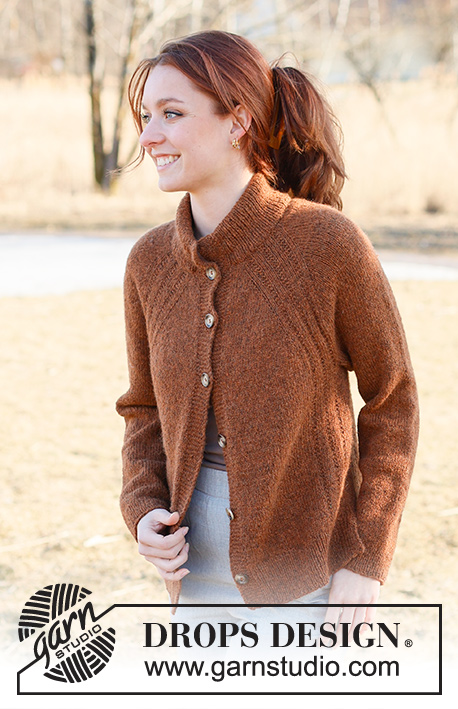



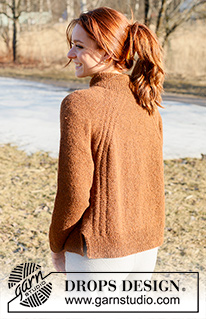
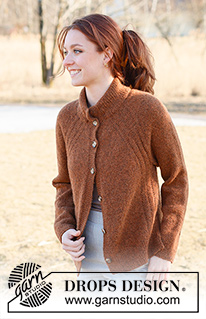
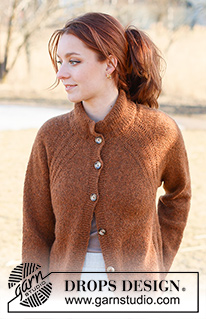















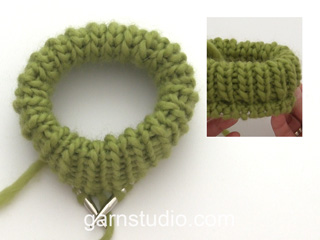



































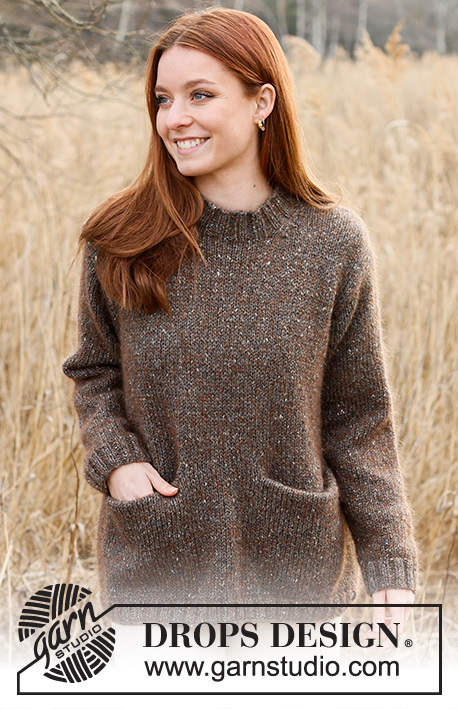







Comments / Questions (17)
Hello again. Further to my previous message, I realised I had missed some increases. I do now have 35 and 69 sts between A2/A3, however I also have 83 sts for the sleeves. Per the instructions I should have a total of 357 sts for size L but I have 381 (including the 8 band sts on either end. Should I have stopped increasing the sleeves 6 rows earlier?
10.02.2024 - 04:14DROPS Design answered:
Dear Kaarina, for the sleeves you should have 19 stitches in the first row. This is the sleeve: knit 1 stitch, make 1 yarn over, knit 15, make 1 yarn over, knit 1, insert a marker thread here (sleeve) = 19 stitches. Now increase like this for the sleeves (= 2 increases in each sleeve) every 2nd row 26 more times = 52 stitches increased in each sleeve. 19 stitches + 52 stitches = 71 stitches. So you should have 12 stitches less in each sleeve than you stated (= 24 less stitches). 381-357 = 24 stitches. Happy knitting!
12.02.2024 - 00:31Begrijp ik het goed dat ik de terugkerende naald moet breien zoals de steken zich voordoen? En de omslagen averechts?
04.02.2024 - 20:39I'm knitting this cardigan in size L. I'm now at the point where I should have 357 sts but the amount of stitches between A2 and A3 on front and back are different (i.e., my row is as follows 8-32-15-77-15-63-15-77-15-32-8). Where did I go wrong? I don't know how I can continue... Help!
29.01.2024 - 04:30DROPS Design answered:
Dear Kaarina, there were 4 sts on each front piece in A.4 at the beg, you increase 4 sts in A.4 and repeat the increases 27more times = 4+4+27=35 sts for front pieces between bands and raglan sts. On back piece you had 7 sts between both A.3, you increase 8 sts in A.4 + 27 more times 2 sts = 7+8+2x27= 69 sts; Hope it can help. Happy knitting!
30.01.2024 - 07:21Thank you for your recent reply however it didn\'t answer my question. I know what ribbing is but the pattern says k1, p1 until the last stitch, then k1 and to repeat this until the work reaches 7cm. If I repeat the same instruction on the other side the first and last stitch will be knit thereby creating a moss stitch. The instruction is misleading...?
07.12.2023 - 17:55DROPS Design answered:
Dear Ulla, from wrong side knit the knit and purl the purl, this means when from RS you start with K1, P1 and end with K1, from WS you will start with P1, K1 and end with P1. Happy knitting!
08.12.2023 - 08:35I love your website and all the patterns you offer. I started this cardigan and have already a question about the neck. I CO 129 stitches and purled first row. Then the instruction is to k1, p1 until the last stitch which will be k1. When I turn it to the WS I start with k1, p1. This gives me moss stitch, not ribbing as mentioned. What am I missing?
06.12.2023 - 17:51DROPS Design answered:
Hi Ulla, When working the rib back from the wrong side, the stitches that were knitted on the right side are purled on the wrong side and the stitches that were purled on the right side are knitted on the wrong side. Happy crafting!
07.12.2023 - 06:43Buongiorno A1eA5 sono messi male. Vanno specchiati altrimenti viene con scollo a V e non come da foto. Purtroppo io me ne sono accorta solo a metà lavoro e non potete immaginare il dispiacere nel disfare specialmente perché stavo facendo una CL
28.11.2023 - 08:01DROPS Design answered:
Buonasera Francesca, non ci sono correzioni riguardo i modelli: ha seguito correttamente la lavorazione partendo dal basso verso l'alto e da destra verso sinistra per i ferri di andata e da sinistra a destra per quelli di ritorno? Buon lavoro!
30.11.2023 - 23:01Hi, I'm knitting the small size & don't quite understand the instructions "At the same time when the diagrams have been worked vertically, repeat the last 2 rows vertically - is this after each vertical repeat or after the 3 pattern repeats. Also, I can't quite make out how the sts increase from 177 to 301 from the Raglan & pattern repeats - I get less than this by calculations. Thanks!
15.11.2023 - 21:00DROPS Design answered:
Dear Graziella, continue increasing for raglan as before an continue working diagrams/pattern as established until you will have a total of 301 sts, ie 55 sts stocking stitch between A.2 and A.3 on back piece, 28 sts stocking stitch between A.2 and A.3 and front band stitches. Happy knitting!
16.11.2023 - 10:10Hallo, Ich bin bei der Passe. Sind in Diagrammen nur die Hinreihen eingezeichnet? Was ist mit den Rückreihen, alles links?
16.10.2023 - 07:56DROPS Design answered:
Liebe Gaby, die Diagramme zeigen alle Reihen, dh die Hin- sowie die Rück-Reihen; siehe Symbolerklärungen. Hier lesen Sie noch mehr. Viel Spaß beim stricken!
16.10.2023 - 10:14I love the look of this cardigan, and am preparing to begin it. My chosen yarn is Pingouin 50wool/25acrylic/15silk and I was wondering if it would work to add in a kid mohair to beef it up a bit? Please advise. Thank you, Margaret
29.09.2023 - 08:44DROPS Design answered:
Dear Margaret, the composition of the yarn is not as important as the actual yardage. We are not familiar with this yarn so we can't assess whether it would be useful for this pattern. Happy knitting!
30.09.2023 - 23:58Hi, this pattern has me completely confused. Please help. For raglan sleeve increases must I just increase the knit 1, make 1 yo, knit 15 make 1 yo, knit 1 for the sleeves. Or do I need to increase as well between A2 and the sleeve marker? How many stitches should I have on my needles after row 3 and then row 5? Does it go 125, 133, 141? Thank you for any help. Regards Judith
25.09.2023 - 13:43DROPS Design answered:
Dear Mrs Brink, increase on sleeve as explained under RAGLAN (applies to sleeves):, this means work until the marker thread at the beginning of the sleeve, than knit 1, increase 1 stitch, work sleeve until 1 stitch remains before the marking thread at the end of sleeve, increase 1 stitch, knit 1. The number of sts between the yarn overs will increases as you increase. This is to increase on sleeves. On front and back pieces, increase as shonw in the diagrams (see written pattern) . Happy knitting!
25.09.2023 - 15:38